Comparative PESTLE Analysis: Canada vs. India in Business Ethics
VerifiedAdded on 2022/08/09
|7
|1294
|219
Report
AI Summary
This report presents a detailed PESTLE analysis, a framework used to examine the external business environments of Canada and India. The analysis encompasses political, economic, social, technological, legal, and environmental factors. In the political arena, Canada is viewed as offering a more favorable environment due to its higher government integrity and lower corporate tax rates compared to India. Economically, both countries present passable conditions, although Canada has a better inflation rate. Socially, both countries present challenges, particularly due to price sensitivity among consumers. Technologically, Canada has a more advanced environment. In terms of legal and environmental considerations, Canada is assessed as superior. The report concludes that Canada offers a more suitable setting for conducting business operations than India, based on the comparative analysis of these factors.
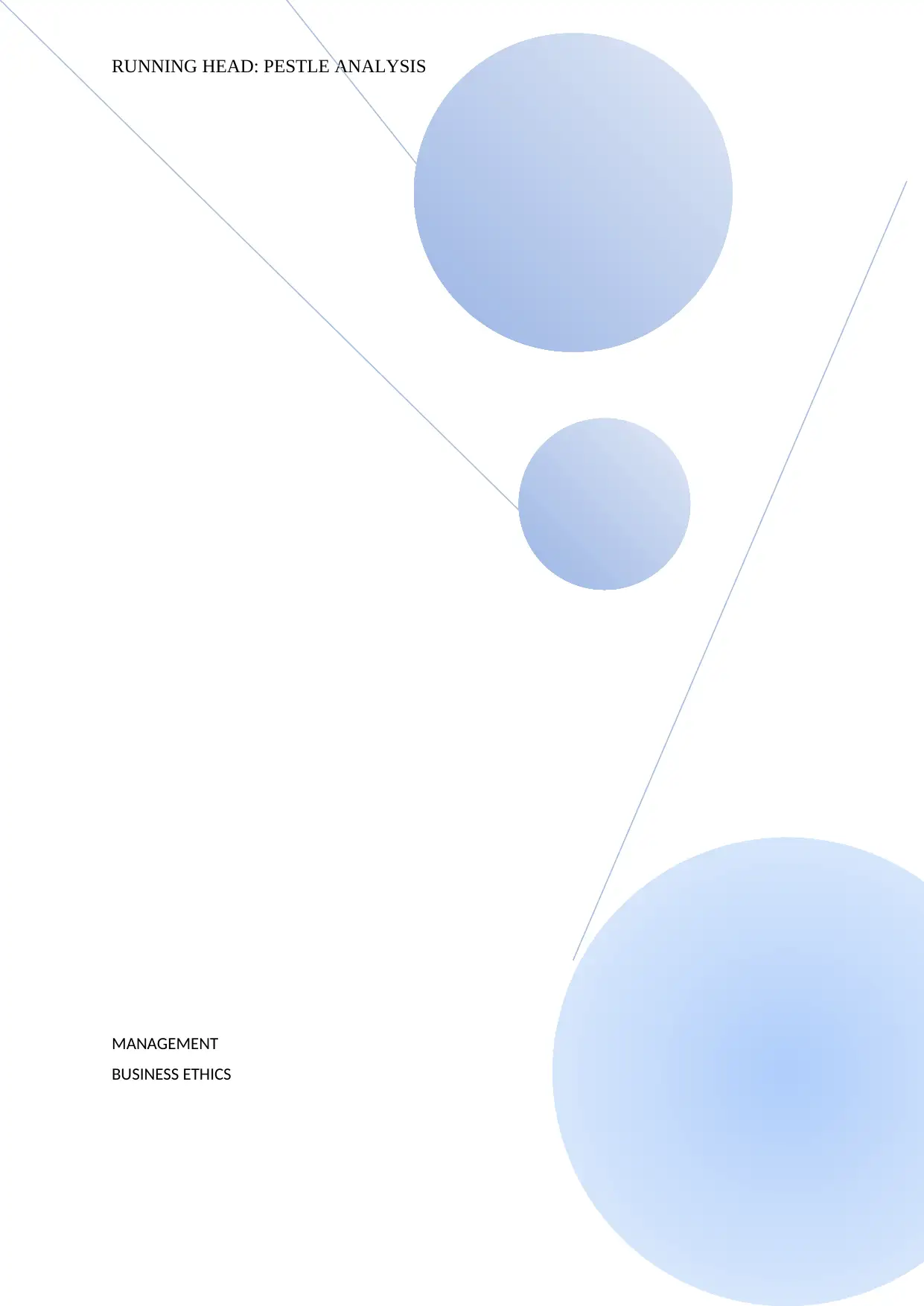
RUNNING HEAD: PESTLE ANALYSIS
MANAGEMENT
BUSINESS ETHICS
MANAGEMENT
BUSINESS ETHICS
Paraphrase This Document
Need a fresh take? Get an instant paraphrase of this document with our AI Paraphraser
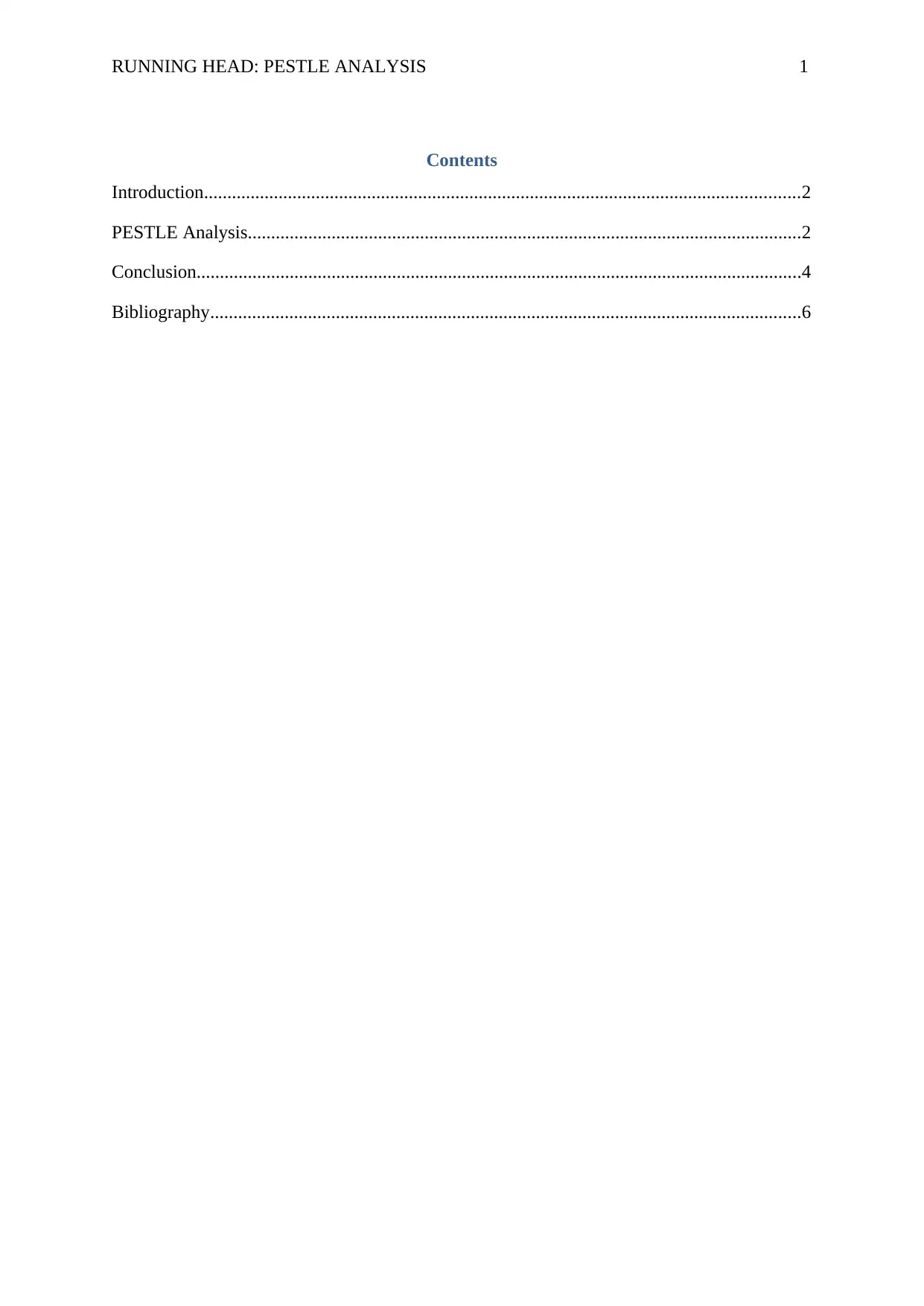
RUNNING HEAD: PESTLE ANALYSIS 1
Contents
Introduction................................................................................................................................2
PESTLE Analysis.......................................................................................................................2
Conclusion..................................................................................................................................4
Bibliography...............................................................................................................................6
Contents
Introduction................................................................................................................................2
PESTLE Analysis.......................................................................................................................2
Conclusion..................................................................................................................................4
Bibliography...............................................................................................................................6
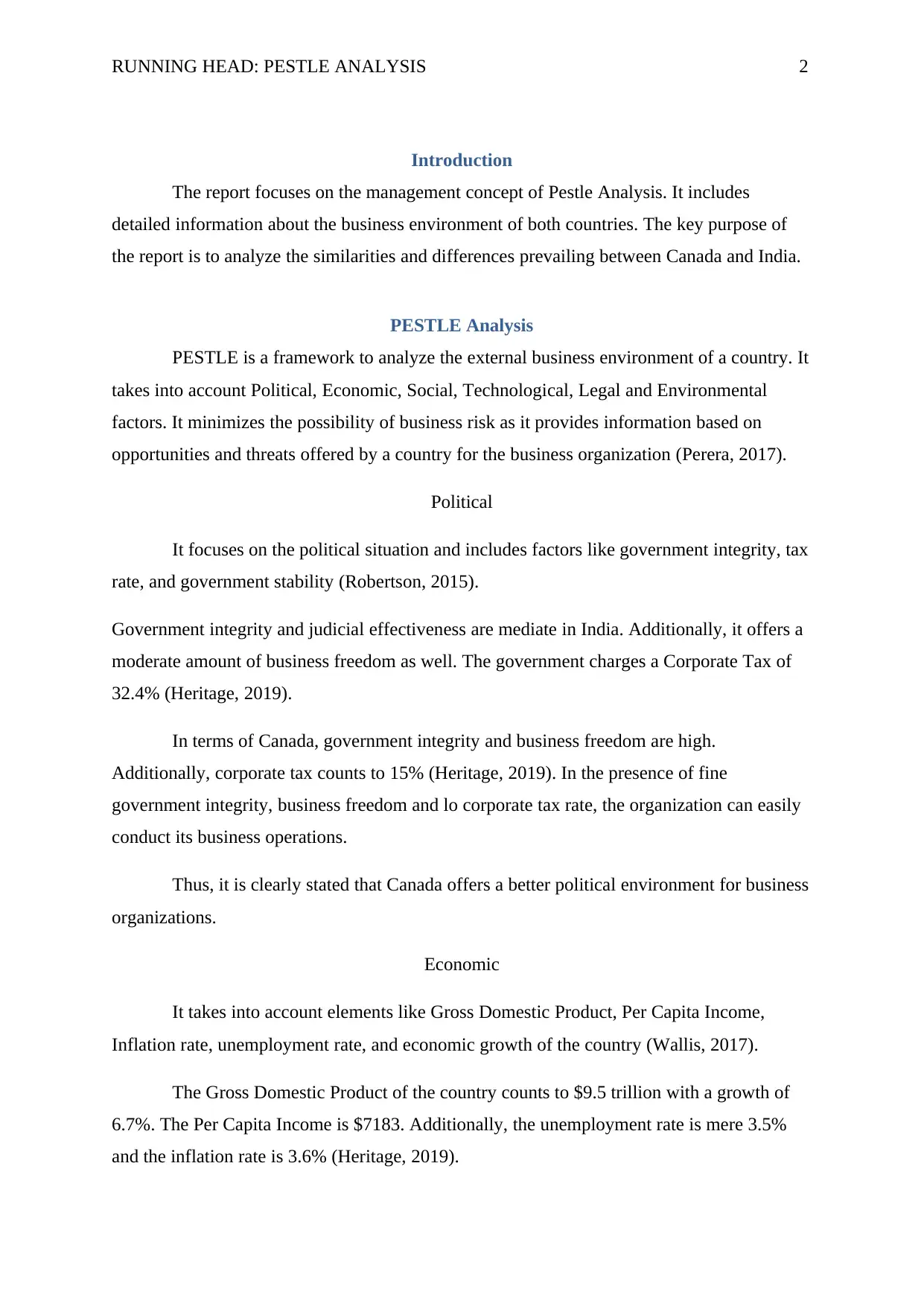
RUNNING HEAD: PESTLE ANALYSIS 2
Introduction
The report focuses on the management concept of Pestle Analysis. It includes
detailed information about the business environment of both countries. The key purpose of
the report is to analyze the similarities and differences prevailing between Canada and India.
PESTLE Analysis
PESTLE is a framework to analyze the external business environment of a country. It
takes into account Political, Economic, Social, Technological, Legal and Environmental
factors. It minimizes the possibility of business risk as it provides information based on
opportunities and threats offered by a country for the business organization (Perera, 2017).
Political
It focuses on the political situation and includes factors like government integrity, tax
rate, and government stability (Robertson, 2015).
Government integrity and judicial effectiveness are mediate in India. Additionally, it offers a
moderate amount of business freedom as well. The government charges a Corporate Tax of
32.4% (Heritage, 2019).
In terms of Canada, government integrity and business freedom are high.
Additionally, corporate tax counts to 15% (Heritage, 2019). In the presence of fine
government integrity, business freedom and lo corporate tax rate, the organization can easily
conduct its business operations.
Thus, it is clearly stated that Canada offers a better political environment for business
organizations.
Economic
It takes into account elements like Gross Domestic Product, Per Capita Income,
Inflation rate, unemployment rate, and economic growth of the country (Wallis, 2017).
The Gross Domestic Product of the country counts to $9.5 trillion with a growth of
6.7%. The Per Capita Income is $7183. Additionally, the unemployment rate is mere 3.5%
and the inflation rate is 3.6% (Heritage, 2019).
Introduction
The report focuses on the management concept of Pestle Analysis. It includes
detailed information about the business environment of both countries. The key purpose of
the report is to analyze the similarities and differences prevailing between Canada and India.
PESTLE Analysis
PESTLE is a framework to analyze the external business environment of a country. It
takes into account Political, Economic, Social, Technological, Legal and Environmental
factors. It minimizes the possibility of business risk as it provides information based on
opportunities and threats offered by a country for the business organization (Perera, 2017).
Political
It focuses on the political situation and includes factors like government integrity, tax
rate, and government stability (Robertson, 2015).
Government integrity and judicial effectiveness are mediate in India. Additionally, it offers a
moderate amount of business freedom as well. The government charges a Corporate Tax of
32.4% (Heritage, 2019).
In terms of Canada, government integrity and business freedom are high.
Additionally, corporate tax counts to 15% (Heritage, 2019). In the presence of fine
government integrity, business freedom and lo corporate tax rate, the organization can easily
conduct its business operations.
Thus, it is clearly stated that Canada offers a better political environment for business
organizations.
Economic
It takes into account elements like Gross Domestic Product, Per Capita Income,
Inflation rate, unemployment rate, and economic growth of the country (Wallis, 2017).
The Gross Domestic Product of the country counts to $9.5 trillion with a growth of
6.7%. The Per Capita Income is $7183. Additionally, the unemployment rate is mere 3.5%
and the inflation rate is 3.6% (Heritage, 2019).
⊘ This is a preview!⊘
Do you want full access?
Subscribe today to unlock all pages.

Trusted by 1+ million students worldwide
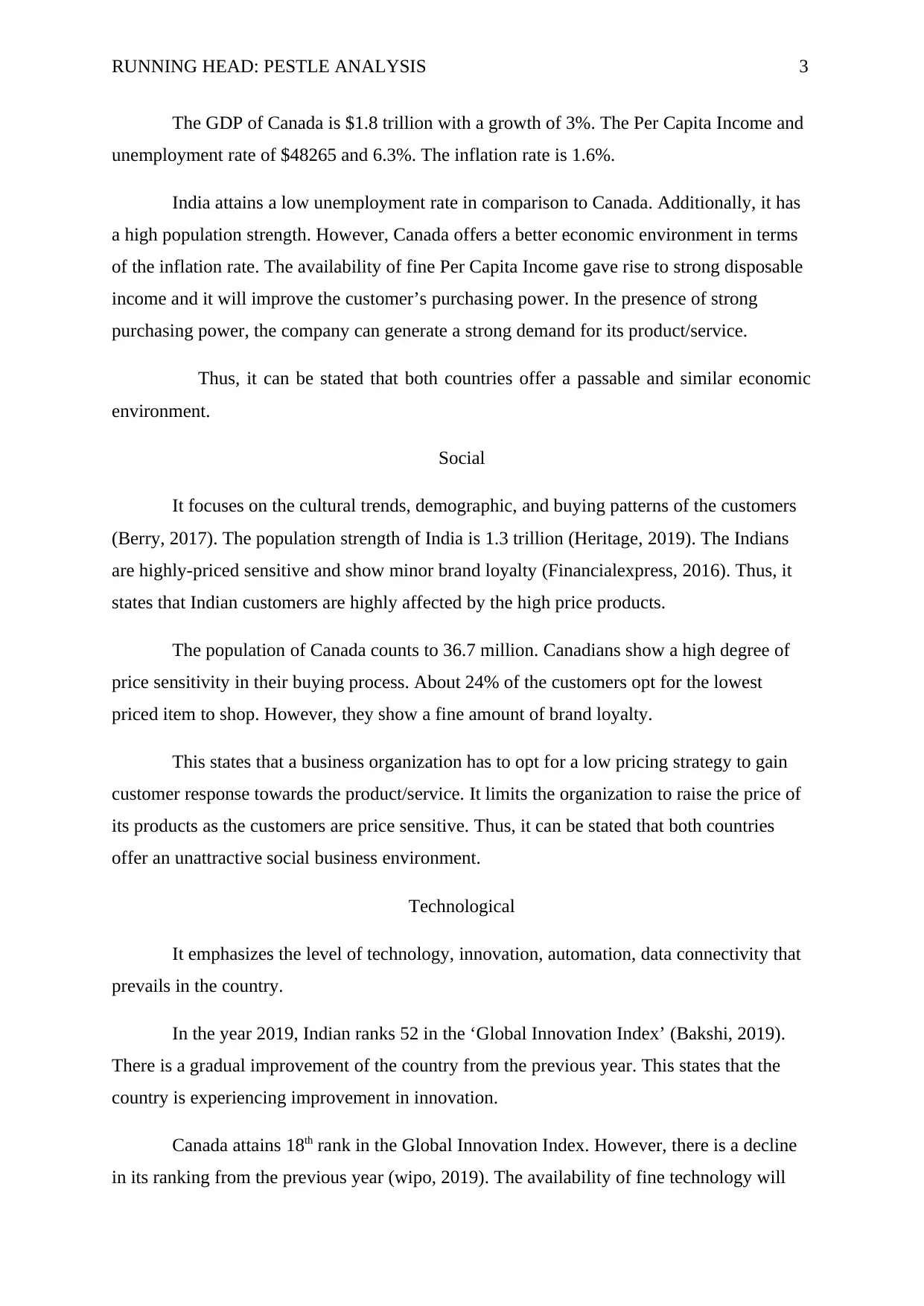
RUNNING HEAD: PESTLE ANALYSIS 3
The GDP of Canada is $1.8 trillion with a growth of 3%. The Per Capita Income and
unemployment rate of $48265 and 6.3%. The inflation rate is 1.6%.
India attains a low unemployment rate in comparison to Canada. Additionally, it has
a high population strength. However, Canada offers a better economic environment in terms
of the inflation rate. The availability of fine Per Capita Income gave rise to strong disposable
income and it will improve the customer’s purchasing power. In the presence of strong
purchasing power, the company can generate a strong demand for its product/service.
Thus, it can be stated that both countries offer a passable and similar economic
environment.
Social
It focuses on the cultural trends, demographic, and buying patterns of the customers
(Berry, 2017). The population strength of India is 1.3 trillion (Heritage, 2019). The Indians
are highly-priced sensitive and show minor brand loyalty (Financialexpress, 2016). Thus, it
states that Indian customers are highly affected by the high price products.
The population of Canada counts to 36.7 million. Canadians show a high degree of
price sensitivity in their buying process. About 24% of the customers opt for the lowest
priced item to shop. However, they show a fine amount of brand loyalty.
This states that a business organization has to opt for a low pricing strategy to gain
customer response towards the product/service. It limits the organization to raise the price of
its products as the customers are price sensitive. Thus, it can be stated that both countries
offer an unattractive social business environment.
Technological
It emphasizes the level of technology, innovation, automation, data connectivity that
prevails in the country.
In the year 2019, Indian ranks 52 in the ‘Global Innovation Index’ (Bakshi, 2019).
There is a gradual improvement of the country from the previous year. This states that the
country is experiencing improvement in innovation.
Canada attains 18th rank in the Global Innovation Index. However, there is a decline
in its ranking from the previous year (wipo, 2019). The availability of fine technology will
The GDP of Canada is $1.8 trillion with a growth of 3%. The Per Capita Income and
unemployment rate of $48265 and 6.3%. The inflation rate is 1.6%.
India attains a low unemployment rate in comparison to Canada. Additionally, it has
a high population strength. However, Canada offers a better economic environment in terms
of the inflation rate. The availability of fine Per Capita Income gave rise to strong disposable
income and it will improve the customer’s purchasing power. In the presence of strong
purchasing power, the company can generate a strong demand for its product/service.
Thus, it can be stated that both countries offer a passable and similar economic
environment.
Social
It focuses on the cultural trends, demographic, and buying patterns of the customers
(Berry, 2017). The population strength of India is 1.3 trillion (Heritage, 2019). The Indians
are highly-priced sensitive and show minor brand loyalty (Financialexpress, 2016). Thus, it
states that Indian customers are highly affected by the high price products.
The population of Canada counts to 36.7 million. Canadians show a high degree of
price sensitivity in their buying process. About 24% of the customers opt for the lowest
priced item to shop. However, they show a fine amount of brand loyalty.
This states that a business organization has to opt for a low pricing strategy to gain
customer response towards the product/service. It limits the organization to raise the price of
its products as the customers are price sensitive. Thus, it can be stated that both countries
offer an unattractive social business environment.
Technological
It emphasizes the level of technology, innovation, automation, data connectivity that
prevails in the country.
In the year 2019, Indian ranks 52 in the ‘Global Innovation Index’ (Bakshi, 2019).
There is a gradual improvement of the country from the previous year. This states that the
country is experiencing improvement in innovation.
Canada attains 18th rank in the Global Innovation Index. However, there is a decline
in its ranking from the previous year (wipo, 2019). The availability of fine technology will
Paraphrase This Document
Need a fresh take? Get an instant paraphrase of this document with our AI Paraphraser
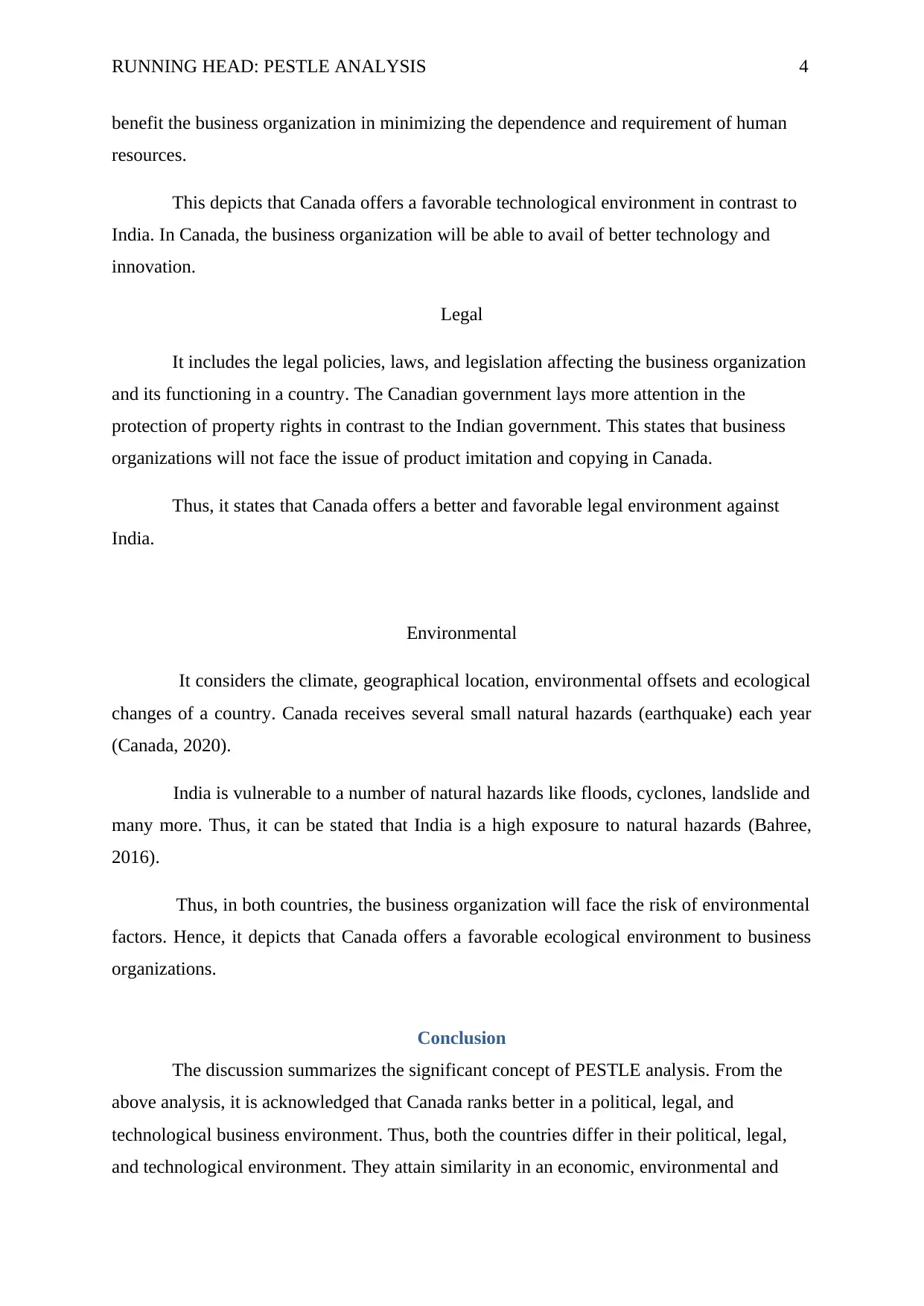
RUNNING HEAD: PESTLE ANALYSIS 4
benefit the business organization in minimizing the dependence and requirement of human
resources.
This depicts that Canada offers a favorable technological environment in contrast to
India. In Canada, the business organization will be able to avail of better technology and
innovation.
Legal
It includes the legal policies, laws, and legislation affecting the business organization
and its functioning in a country. The Canadian government lays more attention in the
protection of property rights in contrast to the Indian government. This states that business
organizations will not face the issue of product imitation and copying in Canada.
Thus, it states that Canada offers a better and favorable legal environment against
India.
Environmental
It considers the climate, geographical location, environmental offsets and ecological
changes of a country. Canada receives several small natural hazards (earthquake) each year
(Canada, 2020).
India is vulnerable to a number of natural hazards like floods, cyclones, landslide and
many more. Thus, it can be stated that India is a high exposure to natural hazards (Bahree,
2016).
Thus, in both countries, the business organization will face the risk of environmental
factors. Hence, it depicts that Canada offers a favorable ecological environment to business
organizations.
Conclusion
The discussion summarizes the significant concept of PESTLE analysis. From the
above analysis, it is acknowledged that Canada ranks better in a political, legal, and
technological business environment. Thus, both the countries differ in their political, legal,
and technological environment. They attain similarity in an economic, environmental and
benefit the business organization in minimizing the dependence and requirement of human
resources.
This depicts that Canada offers a favorable technological environment in contrast to
India. In Canada, the business organization will be able to avail of better technology and
innovation.
Legal
It includes the legal policies, laws, and legislation affecting the business organization
and its functioning in a country. The Canadian government lays more attention in the
protection of property rights in contrast to the Indian government. This states that business
organizations will not face the issue of product imitation and copying in Canada.
Thus, it states that Canada offers a better and favorable legal environment against
India.
Environmental
It considers the climate, geographical location, environmental offsets and ecological
changes of a country. Canada receives several small natural hazards (earthquake) each year
(Canada, 2020).
India is vulnerable to a number of natural hazards like floods, cyclones, landslide and
many more. Thus, it can be stated that India is a high exposure to natural hazards (Bahree,
2016).
Thus, in both countries, the business organization will face the risk of environmental
factors. Hence, it depicts that Canada offers a favorable ecological environment to business
organizations.
Conclusion
The discussion summarizes the significant concept of PESTLE analysis. From the
above analysis, it is acknowledged that Canada ranks better in a political, legal, and
technological business environment. Thus, both the countries differ in their political, legal,
and technological environment. They attain similarity in an economic, environmental and
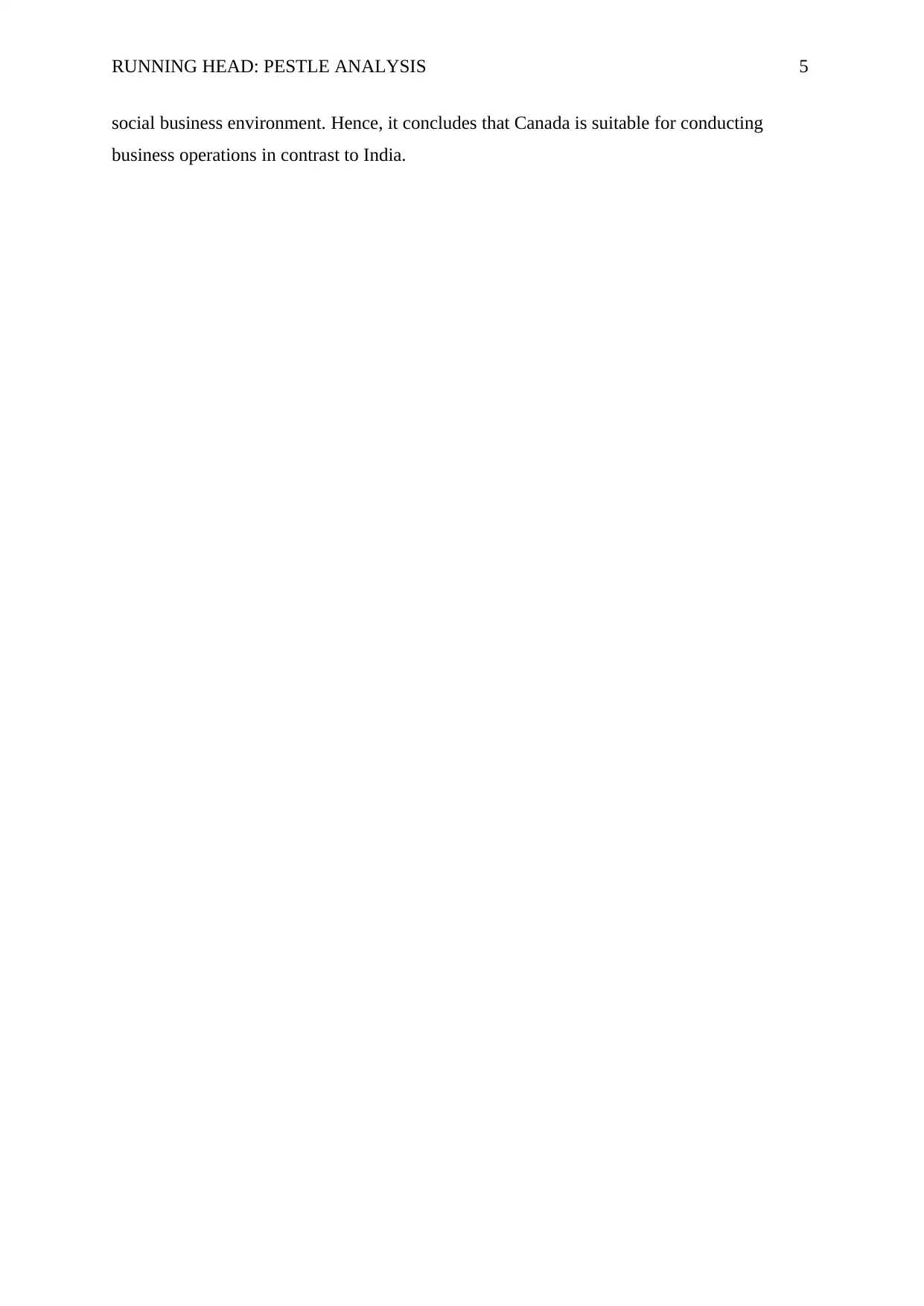
RUNNING HEAD: PESTLE ANALYSIS 5
social business environment. Hence, it concludes that Canada is suitable for conducting
business operations in contrast to India.
social business environment. Hence, it concludes that Canada is suitable for conducting
business operations in contrast to India.
⊘ This is a preview!⊘
Do you want full access?
Subscribe today to unlock all pages.

Trusted by 1+ million students worldwide
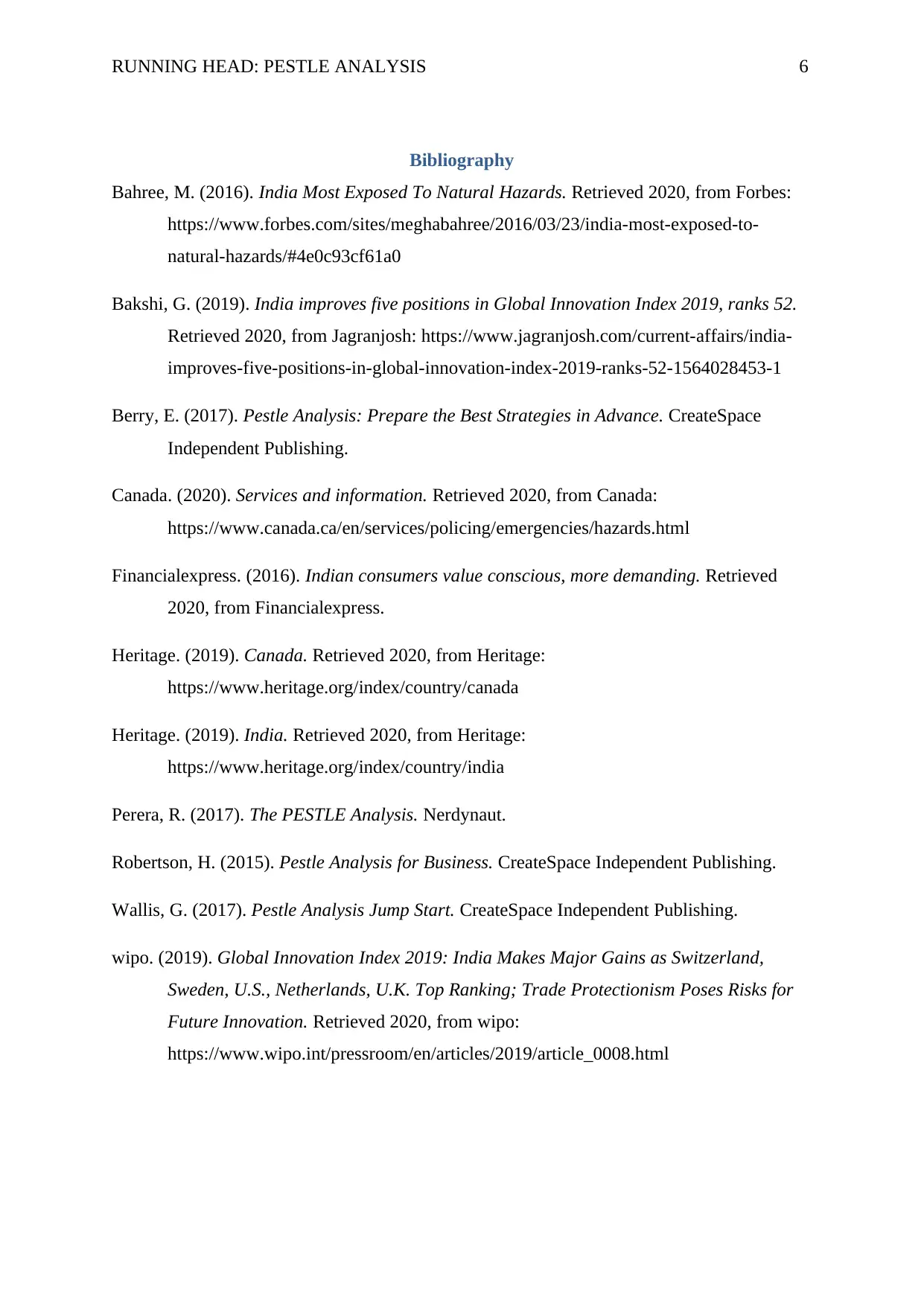
RUNNING HEAD: PESTLE ANALYSIS 6
Bibliography
Bahree, M. (2016). India Most Exposed To Natural Hazards. Retrieved 2020, from Forbes:
https://www.forbes.com/sites/meghabahree/2016/03/23/india-most-exposed-to-
natural-hazards/#4e0c93cf61a0
Bakshi, G. (2019). India improves five positions in Global Innovation Index 2019, ranks 52.
Retrieved 2020, from Jagranjosh: https://www.jagranjosh.com/current-affairs/india-
improves-five-positions-in-global-innovation-index-2019-ranks-52-1564028453-1
Berry, E. (2017). Pestle Analysis: Prepare the Best Strategies in Advance. CreateSpace
Independent Publishing.
Canada. (2020). Services and information. Retrieved 2020, from Canada:
https://www.canada.ca/en/services/policing/emergencies/hazards.html
Financialexpress. (2016). Indian consumers value conscious, more demanding. Retrieved
2020, from Financialexpress.
Heritage. (2019). Canada. Retrieved 2020, from Heritage:
https://www.heritage.org/index/country/canada
Heritage. (2019). India. Retrieved 2020, from Heritage:
https://www.heritage.org/index/country/india
Perera, R. (2017). The PESTLE Analysis. Nerdynaut.
Robertson, H. (2015). Pestle Analysis for Business. CreateSpace Independent Publishing.
Wallis, G. (2017). Pestle Analysis Jump Start. CreateSpace Independent Publishing.
wipo. (2019). Global Innovation Index 2019: India Makes Major Gains as Switzerland,
Sweden, U.S., Netherlands, U.K. Top Ranking; Trade Protectionism Poses Risks for
Future Innovation. Retrieved 2020, from wipo:
https://www.wipo.int/pressroom/en/articles/2019/article_0008.html
Bibliography
Bahree, M. (2016). India Most Exposed To Natural Hazards. Retrieved 2020, from Forbes:
https://www.forbes.com/sites/meghabahree/2016/03/23/india-most-exposed-to-
natural-hazards/#4e0c93cf61a0
Bakshi, G. (2019). India improves five positions in Global Innovation Index 2019, ranks 52.
Retrieved 2020, from Jagranjosh: https://www.jagranjosh.com/current-affairs/india-
improves-five-positions-in-global-innovation-index-2019-ranks-52-1564028453-1
Berry, E. (2017). Pestle Analysis: Prepare the Best Strategies in Advance. CreateSpace
Independent Publishing.
Canada. (2020). Services and information. Retrieved 2020, from Canada:
https://www.canada.ca/en/services/policing/emergencies/hazards.html
Financialexpress. (2016). Indian consumers value conscious, more demanding. Retrieved
2020, from Financialexpress.
Heritage. (2019). Canada. Retrieved 2020, from Heritage:
https://www.heritage.org/index/country/canada
Heritage. (2019). India. Retrieved 2020, from Heritage:
https://www.heritage.org/index/country/india
Perera, R. (2017). The PESTLE Analysis. Nerdynaut.
Robertson, H. (2015). Pestle Analysis for Business. CreateSpace Independent Publishing.
Wallis, G. (2017). Pestle Analysis Jump Start. CreateSpace Independent Publishing.
wipo. (2019). Global Innovation Index 2019: India Makes Major Gains as Switzerland,
Sweden, U.S., Netherlands, U.K. Top Ranking; Trade Protectionism Poses Risks for
Future Innovation. Retrieved 2020, from wipo:
https://www.wipo.int/pressroom/en/articles/2019/article_0008.html
1 out of 7
Related Documents
Your All-in-One AI-Powered Toolkit for Academic Success.
+13062052269
info@desklib.com
Available 24*7 on WhatsApp / Email
![[object Object]](/_next/static/media/star-bottom.7253800d.svg)
Unlock your academic potential
Copyright © 2020–2025 A2Z Services. All Rights Reserved. Developed and managed by ZUCOL.





